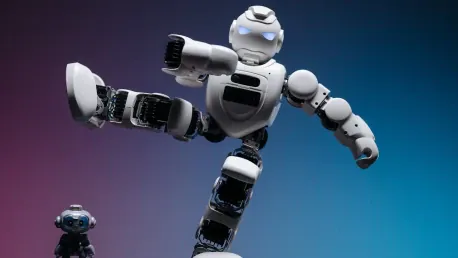The field of humanoid robotics is on the brink of a significant breakthrough, with advancements in technology and artificial intelligence driving the development of robots capable of performing a wide range of tasks. As of 2024, the integration of humanoid robots into industrial settings and potentially broader applications is becoming increasingly feasible. This article delves into the companies leading the charge in humanoid robotics, the technological advancements propelling this field, and the societal implications of widespread robot adoption.
Technological Advancements Driving Humanoid Robotics
The rapid progress in computing power and AI has been a game-changer for humanoid robotics. Innovations such as Nvidia’s Jetson Thor and specialized AI algorithms have enabled robots to perform complex tasks with greater efficiency and precision. These advancements have addressed many of the technical limitations that previously hindered the development of humanoid robots. Given the consistent improvement in machine learning and sensor technologies, humanoid robots are now capable of effectively navigating and interacting with their environments.
Moreover, these robots are equipped with advanced sensors, machine learning capabilities, and improved processing units, allowing them to tackle a multitude of tasks previously unimaginable. From precision control to complex decision-making algorithms, current technological interventions have made humanoid robots more adaptable and versatile. This technological leap has opened up new possibilities for their application in various sectors, including manufacturing, logistics, and even customer service.
These rapid advancements mean that robots are no longer restricted to the confines of research labs. With enhanced functionalities, humanoid robots are now poised to enter real-world applications, making significant strides in efficiency and productivity. For instance, the ability to process vast amounts of data in real-time and make accurate decisions is enabling these robots to conduct complex inspections and maintenance tasks in industrial settings, heralding a new era of automation.
Market Presence and Economic Impact
The growing number of companies investing in humanoid robotics signifies the anticipated market boom for these sophisticated machines. Financial investments in this field are substantial, with companies like Tesla, Agility Robotics, and Figure AI leading the way. These investments are expected to drive significant market growth, with projections indicating a rise from $2 billion in 2024 to $13.25 billion by 2029. This surge in interest and funding underlines the promising future of humanoid robotics and its transformative potential across various industries.
In addition to market growth, the economic implications of humanoid robots are profound. By automating repetitive and hazardous tasks, these robots can greatly enhance productivity and operational efficiency in industries facing labor shortages. This shift could lead to significant cost savings and increased competitiveness for businesses that adopt humanoid robotics. For example, the ability of robots to work around the clock without the need for breaks or rest drastically improves the output within manufacturing units and logistics operations.
Moreover, the proliferation of humanoid robots could foster new job opportunities in fields such as robot maintenance, programming, and AI oversight. While there are concerns about job displacement, the creation of new roles in these emerging sectors may mitigate some of these impacts. As industries evolve to incorporate more robots, the economic landscape will likely shift, creating a symbiotic relationship between human workers and their robotic counterparts. This dynamic is expected to ultimately drive economic growth and innovation across various sectors.
Practical Applications in Industrial Settings
Humanoid robots are already making their mark in industrial settings, particularly in logistics and manufacturing. Companies like BMW and Amazon are actively testing these robots in their operations, highlighting their potential to significantly improve labor efficiency. In warehouses and factories, humanoid robots are being used for tasks such as lifting, moving, welding, and conducting inspections. Their physical capabilities, combined with advanced AI, make them ideal candidates for roles requiring precision and endurance.
The ability of humanoid robots to perform physically demanding and repetitive tasks makes them an invaluable asset in these environments. Their deployment can reduce the risk of workplace injuries and free up human workers for more complex and creative roles. This not only enhances productivity but also improves job satisfaction as humans can focus on tasks that require critical thinking and creativity. For instance, in the automotive industry, robots are taking over repetitive welding tasks, allowing human workers to concentrate on design and quality control.
Furthermore, the flexibility and adaptability of humanoid robots allow them to seamlessly integrate into various industrial workflows. This is particularly evident in logistics, where robots are used for inventory management, sorting, and packing tasks. Their ability to operate in dynamic environments and interact with human workers enhances overall operational efficiency. The practical deployment of humanoid robots underscores their value in boosting industrial productivity and safety, making them indispensable in the modern industrial landscape.
Companies Leading the Charge in Humanoid Robotics
Tesla’s Optimus, unveiled in 2021, is designed to handle general-purpose tasks that are dangerous, repetitive, and boring for humans. With a projected low-volume production start by 2025, Optimus aims to be an affordable solution for various industries, with a target price range of $20,000 to $30,000. Tesla’s entry into the humanoid robotics market signifies the potential these robots hold in transforming everyday labor tasks into more automated processes. This robot is geared towards sectors that require both manpower and precision, indicating a significant step toward the future of industrial automation.
Founded in 2015, Agility Robotics developed Digit, a bipedal humanoid tailored for logistics and warehouse operations. Digit is already deployed in facilities like Spanx warehouses and tested by Amazon, showcasing its practical application in distribution and fulfillment sectors. This robot’s flexibility and efficiency in carrying out tasks such as loading and unloading items highlight the increasing reliance on humanoid robots within the logistics domain. Agility Robotics continues to push the boundaries of what humanoid robots can achieve in practical, real-world scenarios.
Established in 2022, Figure AI focuses on AI-powered humanoid robots for manual labor. In 2024, they secured significant funding, valuing the company at $2.6 billion. Figure 02 robots are currently undergoing testing in BMW’s manufacturing environments, demonstrating their potential in industrial settings. These robots are designed to assist in physically demanding tasks, further augmenting human efforts in manufacturing units. Figure AI’s strategic investment in advanced AI technologies underscores the potential of these robots to revolutionize industrial applications, offering a glimpse into the future of smart factories.
Societal Implications and Ethical Considerations
The integration of humanoid robots into everyday life raises important societal and ethical questions. One of the primary concerns is the potential displacement of human workers. As robots take over repetitive and hazardous tasks, there is a risk of job losses in certain sectors. However, this displacement could be mitigated by the creation of new roles that focus on robot maintenance, programming, and oversight. The challenge lies in ensuring a smooth transition, where displaced workers can be retrained and absorbed into new job roles within the evolving ecosystem.
Human-robot interaction is another critical area of consideration. Ensuring that robots can safely and effectively interact with humans is essential for their successful integration. The ethical implications, such as the treatment of robots and their impact on human relationships, also need to be addressed as humanoid robots become more prevalent. For instance, the concept of robot rights and the ethical use of robots in various applications are topics that require thorough discussion and deliberation. The balance between leveraging robotic capabilities and maintaining human dignity and job security will be paramount.
The broader societal impacts include changes in workforce dynamics and the potential reshaping of industries. As more repetitive and hazardous jobs are automated, humans will need to adapt by acquiring new skills and embracing more complex roles. Educational systems and policies must evolve to support this transition, ensuring that the workforce is prepared for the changes ahead. By addressing these ethical and societal implications proactively, we can foster an environment where humanoid robots enhance human capabilities and coexist harmoniously within our daily lives.
Future Prospects and Market Growth
The future of humanoid robotics looks promising, with continued advancements in AI and computing power driving innovation. Companies are expected to develop more sophisticated and capable robots, expanding their applications beyond industrial settings to areas such as healthcare, security, and domestic environments. This expansion highlights the versatility and potential of humanoid robots to transform multiple sectors, offering solutions to complex problems and enhancing quality of life.
The anticipated market growth for humanoid robots underscores their potential to become an integral part of various sectors. As these robots become more affordable and versatile, their adoption is likely to increase, leading to significant changes in how industries operate and how humans interact with machines. For example, in healthcare, humanoid robots could assist in patient care, rehabilitation, and surgical procedures, providing a level of precision and consistency that is unprecedented. In security, robots could be deployed for surveillance, threat detection, and emergency response, enhancing both efficiency and safety.
Moreover, domestic environments stand to benefit from humanoid robots designed to assist with everyday tasks such as cleaning, cooking, and eldercare. The convenience, reliability, and efficiency provided by these robots could significantly improve the quality of life for individuals, especially those with specific needs. As the market continues to grow and technology evolves, we can expect humanoid robots to integrate seamlessly into various aspects of our daily lives, paving the way for a future where human-robot collaboration is commonplace.
Conclusion
The realm of humanoid robotics is on the cusp of a major shift, thanks to rapid advancements in technology and artificial intelligence. By 2024, the possibilities for integrating humanoid robots into various industries and potentially more extensive applications are becoming increasingly realistic. These robots are expected to take on a range of tasks that were previously unimaginable. This article takes a closer look at the companies spearheading the innovation in humanoid robotics, sheds light on the cutting-edge technologies driving this field forward, and examines the societal impacts that may arise from the widespread adoption of robots.
Several companies are at the forefront of this revolution, leveraging AI to create robots that can mimic human actions and interact seamlessly with their environments. These advancements include improvements in machine learning algorithms, sophisticated sensor technologies, and more resilient and adaptable robotic hardware. Such technologies enable these robots to perform complex tasks, from manufacturing processes to customer service roles.
The implications of adopting humanoid robots on a wide scale are profound. On one hand, there is the potential for increased efficiency and productivity in various sectors. On the other hand, societal concerns about job displacement, ethical considerations, and the need for new regulatory frameworks will undoubtedly arise. As we stand on the brink of this new era, it is essential to weigh the benefits and challenges that come with welcoming humanoid robots into our workplaces and daily lives.









